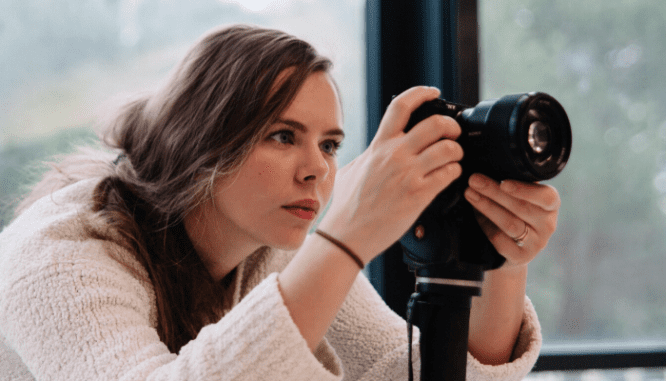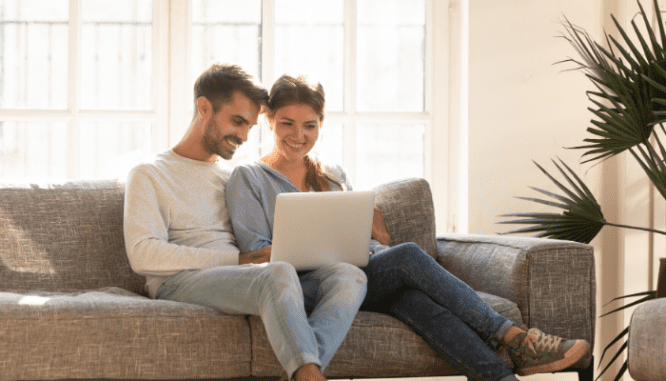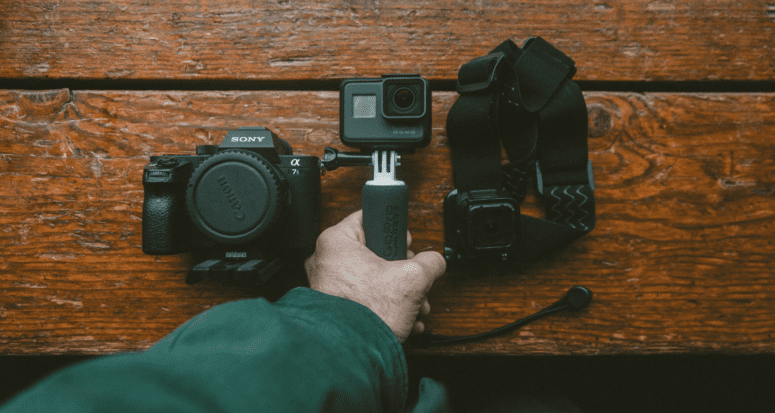Virtual Open Houses: Inside the Latest Digital Twist For Selling Homes
- Published on
- 5 min read
-
 Presley Attardo Contributing AuthorClose
Presley Attardo Contributing AuthorClose Presley Attardo Contributing Author
Presley Attardo Contributing AuthorPresley is a Seattle based writer covering interior design trends, home improvement, and market updates. She has lived in San Francisco, Los Angeles, Chicago, and Washington, D.C., giving her a unique perspective on the diversity of U.S. real estate.
While hosting a physical open house may be off the table for quite some time, you can embrace the innovation of virtual open houses to market your home in the same social spirit. Virtual open houses use livestream technology to share your home with buyers so they can enjoy it from the comfort and safety of their living rooms.
With help from your agent leading the tour, buyers can experience a property fully — from the views outside your window to the insides of your closets — but 100% digitally. Though you can’t quite replicate the fresh baked cookies, silver balloons, and linen scented candles of a traditional open house online, a virtual open house offers buyers a safe, socially distant, and truly engaging way to view your home. Plus, unlike a 1:1 virtual walkthrough, virtual open houses can also stoke a little competition among remote attendees.
We’ll walk you through the ins and outs of hosting a virtual open with expert tips from top real estate agent Amanda Howard, who sells 82% more single-family homes than the average agent in Hunstville, Alabama. Lending fresh insight from her team’s seven recent virtual open houses, Howard shares the foolproof steps to make buyers show up and swoon.

Livestreamed virtual open houses are king
Livestreamed virtual open houses are the best digital alternative to a traditional open house because they receive far better engagement than recorded alternatives. Howard shares her team’s success:
“Our livestreamed open houses actually had double [the views compared to our recorded open houses]. When live, the video would have a couple of hundred views on the agent’s page and then once it was saved, we posted the video on our page and got a couple of hundred more views. I highly recommend live over recorded. There was an obvious difference in views.”
Your agent will host on a shareable livestreaming platform
The best streaming platforms are those your buyers already use regularly: Facebook, Instagram, YouTube, and Zoom. The more familiar your buyers are with the platform, the easier it is for them to participate and share the stream with their friends.
Platforms like Facebook, YouTube, and Instagram allow participants to comment and share reaction emojis on-screen. Video conferencing platforms including Zoom share buyers’ own video or audio, though your agent can moderate participation by hiding and muting participants to prevent distractions like background noises.
Digitally promote your event with all the tricks in the book
With a virtual open house, no neighborhood signs are needed — all of your promotion happens in the digital space.
Your best digital marketing tactics include:
Social media posts and reposts:
Create save-the-date, teaser, and reminder posts to share on your agent’s, their agency’s, and your personal social media accounts. For the best engagement, post slideshows and video posts over still images.
E-blasts:
Send a virtual open house announcement including time, date, and information on how to join your agent’s contact lists.
Facebook Live event:
Howard recommends inviting your network to a Facebook Live event page. Everyone who RSVPs as “going” will receive notifications as the start time approaches.

Agents play host during virtual open houses
Your agent can shoot the livestream with a professional camera or with their smartphone using a gimbal to stabilize the footage. Depending on your agent’s preference, they will host the open house solo or with a partner for production support.
Agents going solo will stay behind the camera, shoot the video, narrate, and respond to buyers’ comments as they pop up on the live stream platform. Agents who partner up will host the tour in front of the camera while their production support shoots the video and shares the buyers’ comments as they appear on-screen for the agent to answer.
Introduction selfie
Your agent will kick-off the livestream with some selfie time, telling visitors who they are and giving the first glimpse of your property. This introduction not only gives buyers some context on the home, but provides time for more people to join the live stream. Howard describes her teams’ go-to introduction:
“You remind people what you’re there for, to do an open house, and share where the location is, some highlights of the area, and maybe highlights of what your specialty [as an agent] is in real estate while you’re waiting for people to come in. So you just chit-chat for a little bit for people to really gather in and repeat yourself often, reminding people why you’re there.”
In this time, buyers may start commenting with questions about your home, which your agent can answer in real-time.
Grand home tour
About five minutes in from the start time, your agent will begin the tour portion of the virtual open house. At this point, your home takes center stage. Your agent should provide light commentary while occupying little to no screen space.
Slowly walking through the house, they’ll describe each room’s features, pointing out materials, opening cabinets and closet doors, and any other action that may help the buyer experience the space.
To maintain a social atmosphere akin to a traditional open house, your agent will interact with buyers as much as possible, responding to their questions and comments and customizing views upon request.
“You keep watching the messenger so when people comment, ‘I love how the sunlight comes in the living room,’ you interact and say, ‘You’re right, I’m so glad, Kathy, that you said you loved the sunlight coming in — it is so beautiful. Let me give you a view of what it looks like out this window,'” shares Howard. “That type of interaction is really key when you’re live.”
Howard also suggests welcoming people by name as they join the live stream, thanking them for joining and recapping information such as the name of property and room they’re seeing. If a buyer joins late and asks to view a room already shown, your agent can circle back to the room at the end of the tour.
Bonus Q&A session
At the end of your tour, your agent can open up the floor to buyers by asking if anyone has any questions or comments they’d like to share. If your agent was filming the tour, they may return to the front of the camera.
When the time comes to conclude the Q&A, your agent will leave buyers with a call-to-action, encouraging them to direct message them for more information. This way, your agent can follow up with interested buyers to answer any outstanding questions and arrange private showings.
Sellers handle behind-the-scenes prep work
If your agent is the host of the show, you’re the production assistant. Nearly identical to a seller’s responsibilities for a traditional open house, your job is to make your home look beautiful for the camera and give your agent tips to show off its best features.
Give your home a makeover
“There’s most likely going to be some handyman items or, as I call them, “honey-do list items” that you need to do to clean and spruce up your property,” Howard advises. If you want to limit in-person meetings, Howard recommends arranging a virtual walk-through on FaceTime with your agent so they can help assign a list of necessary projects.
For most homeowners, this list will include:
Deep cleaning:
Clean your home like your sale depends on it with HomeLight’s exhaustive checklist. Don’t forget to organize the inside of closets, drawers, and pantries in case buyers request a peak.
Decluttering:
Decluttering is an essential pre-open house task, especially if your home is filled to the brim with a lifetime’s worth of stuff. Start decluttering as soon as you decide to sell your home with our decluttering checklist.
Depersonalizing:
Neutralize your home by taking down family photos, kids’ artwork, and religious and political items. Before the virtual open house, hide any pet accessories including beds, toys, and water bowls, along with your pets themselves. Some buyers may associate your cuddly friends with undesirable smells and stains so it’s best to play it safe and remove any reminders.
Boosting curb appeal:
In HomeLight’s Top Agent Insights Q2 2019 Report, 94.25% of agents agree that great curb appeal adds to a seller’s bottom line. Our agents’ top recommended projects include laying fresh mulch liberally and servicing your lawn; these low-cost upgrades will make your home’s exterior shine on camera.
Experiment with flattering lighting
Help your agent out and run some lighting tests. Determine which time of the day your home fills with natural light and play with overhead lighting to achieve the perfect ambiance. Shoot test videos on your phone or laptop to see how the lighting translates on video. Soft, warm lighting that appears intimate and inviting in person may make rooms appear darker and smaller on-screen.
Brief your agent on your home’s most important details
Before your agent goes live, refresh them on your home’s history and best features so they can highlight recent remodels, completed repairs, specific materials, and community culture.
Disappear off-stage while your agent goes live
On the day of the event, tidy up your personal belongings, step out of the house, and let your agent handle the rest. With you out of the house, your agent can move around freely without any awkward background noises or movements. Plus, your buyers will feel more comfortable sharing honest questions and feedback knowing the seller’s not lingering somewhere off-camera.
Share the recording for those who missed the live stream
Your agent will also post the recording of the open houses on their individual and agency’s social media accounts so those who missed the live stream can experience the event. As a seller, you should repost the video to your personal social accounts or share the video over email. You never know, your buyer could just be one mutual friend away.

Pros and cons of virtual open houses
All in all, a virtual open house is an excellent tool to market your home and expose it to prospective buyers. It gives buyers an opportunity to learn more about your home which can help solidify their interest, inspire them to contact your agent, or even make a sight-unseen offer.
When comparing their ability to showcase your home compared to traditional open houses, virtual open houses have their pros and cons:
Pros:
- Buyers can see the home in greater detail than they can in still photos and digital 3D tours.
- Virtual open houses are easier for buyers to attend, especially those who live out of the area.
- Your agent can interact with buyers and answer their questions in real time just like an in-person open house.
- Virtual open houses and their respective promotions help market the home online, increasing your home’s exposure.
- You can share recordings of the virtual open house for those who missed the event.
- Virtual open houses are safe during a pandemic.
Cons:
- The buyer’s experience is limited to the agent’s point of view. They can’t just roam room to room privately at their own pace, returning to rooms whenever they please.
- Buyers miss the context of your location; the buyer skips the car ride into the area, through the neighborhood, and down the street.
- Digital interaction between the buyer and your agent is fairly one-sided. Depending on the streaming platform, your agent may never see the buyer. Howard shares:
“You can’t really replace face-to-face interaction and rapport building. When it’s live and somebody sees you, it’s a little bit different. The client may feel a little bit more of a connection when they can see you and they interact with you and they can see your sense of humor and your professionalism. But it’s one-sided — you don’t get to see them”.
Virtual open houses give your home exposure
A well-executed virtual open house provides buyers with a better remote experience than photos and slideshows alone. Convenient for buyers and easy for sellers, the popularity of these virtual events — along with surging use of virtual tours to accompany listings — will likely continue long after the pandemic subsides.
Header Image Source: (Jakob Owens / Unsplash)
All product names, logos, and brands are property of their respective owners. All company, product and service names used in this website are for identification purposes only. Use of these names, logos, and brands does not imply endorsement or any affiliation with HomeLight.
